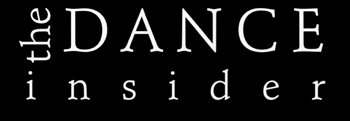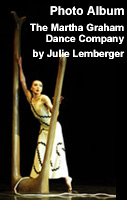|
Brought to
you by

the New
York manufacturer of fine dance apparel for women and girls. Click
here to see a sample of our products and a list of web sites
for purchasing.
With Body Wrappers it's always performance
at its best.
Go back to Flash Reviews
Go
Home
Flash News & Analysis, 3-24: Who
Owns Martha Graham?
Protas Gets His Close Up, and Dancers Get Their Day in Court
"Can you yourself perform the Martha
Graham technique?"
--Dale Cendali, attorney for the
Martha Graham Center of Contemporary Dance, questioning Ron Protas
"What do you mean, perform?"
--Ron Protas, Martha Graham's heir,
currently suing the Graham Center to stop it from using Graham's name
"You have tried to elicit from Mr.
Protas some definition of her technique, without success."
--Federal Judge Miriam Goldman Cedarbaum,
to James McGuire, lawyer for Ron Protas
"This trial is going to influence
us in our lives: If we can perform the Graham work, or if we should leave: We
are still young, we need to dance. That influences our lives now, not the past."
--Yuko Suzuki, Graham dancer
By Paul Ben-Itzak
Copyright 2001 The Dance Insider
After nearly ten years as the artistic
director of the most famous modern dance company in the world, Ron Protas finally
got his close-up yesterday on the witness stand in Federal court for the Southern
District of New York, and he wasn't ready for it. And the dancers of the Martha
Graham company and ensemble finally got their day in court, as Protas was forced
to admit under oath that he could not perform the Martha Graham technique to whose
name he claims exclusive rights.
"It was about time that we fight
for a final ending of all this trouble," proclaimed a subdued Maurizio Nardi,
a dancer with the Martha Graham Ensemble, after the third day of testimony in
Protas's lawsuit to stop the Graham Center and School from using the names Martha
Graham or Martha Graham Technique, which he claims to own as Graham's principal
heir. When she died in 1991, Graham left Protas everything she owned. The center's
defense is based in part on questioning exactly what Graham owned, including the
claim that Graham granted the school the right to use her name in the 1950s, when
it changed from a sole proprietorship owned by her to a public not-for-profit
entity.
Judge Miriam Goldman Cedarbaum signaled
her skepticism towards Protas's claim to the trademark for "Martha Graham Technique"
when she stated, before he even resumed testifying yesterday, "I have entirely
peripheral objections to the notion that a method of dance is trademarkable."
Protas filed suit in January, after
the school re-opened its doors, claiming the school did not have the right to
use the Martha Graham name without obtaining a license from the Martha Graham
Trust which Protas directs. Protas himself recently established a Martha Graham
School and Dance Foundation, whose plans, he says, include licensing the Graham
ballets to schools for $1 per year.
New York State attorney general Eliot
Spitzer has joined the suit as a Defendant-Intervenor, the idea being that the
citizens of New York have an interest and investment in the outcome of the case.
Much of Protas's testimony yesterday,
which began with examination by his lawyer James McGuire, consisted of trying
to document that Graham's name itself had been considered a marketable asset,
and that Martha Graham herself had tried to capitalize on it. But Cedarbaum appeared
reluctant to accept this line of reasoning.
In 1991, Protas said, the year she
passed away, Graham asked him to explore the possibility of a Graham fashion line
with a Japanese Kabuki artist. This testimony caused the judge to remark, "I don't
think that Martha Graham as a visionary force in fashion is at stake."
McGuire also sought to establish
that Protas was pressured into signing a 1998 agreement that created the trust
to license Graham's ballets to the Graham company and others. Protas singled out
former Graham development and executive director Todd Dellinger as indirectly
pressuring him into signing the agreement, by inferring that if he didn't, as
Protas told it, "Board members and Mr. (Theodore) Bartwink would go through the
will looking for loopholes... (and try to) get rid of me." Bartwink is the executive
director of the Harkness Dance Foundation.
The judge also noted that Protas
had been unable to define the Martha Graham technique. Addressing McGuire and
referring to Thursday's testimony, she reminded him, "You have tried to elicit
from Mr. Protas some definition of her technique, without success."
In her cross-examination, center
attorney Dale Cendali sought to establish Protas's lack of a dance background
and inability to actually perform the Graham technique.
"Ever work for a dance company before"
he became the Graham Center's executive director in 1992, she asked.
"No," answered Protas.
"You don't consider yourself a dancer?"
"No."
"What classes have you had, if any?"
"I had Ms. Graham instruct me, in
her home."
After comparing this testimony with
Mr. Protas's deposition, Cendali continued, "I take it you've never performed
in a Martha Graham work?
"No," affirmed Protas.
At this point, the colloquy took
on a Clintonesque, "It depends what is is" turn, as the attorney asked Protas,
"Can you yourself perform the Martha Graham technique?"
"What do you mean, perform?" Protas
asked. "I was taught the essence and spirit of her work."
"So you can't perform it?" she pressed
him a little later.
"No."
In seeking to establish the legitimacy
of its school, center attorneys are expected to call Stuart Hodes, the eminent
Graham dancer and one of her earliest male partners, and current director of the
Graham school.
One of the trial's lowest points
came when Protas sought to discredit Hodes, widely acknowledged as a legendary
Graham dancer and partner.
"Who is Stuart Hodes?" Cendali asked
Protas.
"A partner of Ms. Graham in the 1950s,"
answered Protas.
"A principal dancer?"
"Yes, you might call him that. Ms.
Graham did not consider him a great dancer...." Maintaining that she had trouble
finding male dancers, Protas continued, "She took what she could get."
The judge admonished Protas not
to go there, and Cendali continued, "Do you feel Mr. Hodes is qualified to teach
Ms. Graham's technique?"
"I do not know."
At times yesterday afternoon, the
judge appeared to lose patience with Protas. After he thanked her out loud for
sustaining an objection from his lawyer, she scolded him, "Please don't comment
on my rulings."
The judge also actively questioned
Protas, asking him at one juncture to explain the intent of the school and foundation
he recently established. "What does this school and dance foundation do?"
It will "allow schools to do Martha's
ballets for $1 a year," among other things, Protas promised. "I'm deeply concerned
that at this (time) Martha's ballets are not seen.... For her work to lose two
years of not being seen is a crime. That's what (the foundation is) doing....
It's not to make a lot of money."
The Graham company suspended operations
late last May, citing financial problems, and has not performed since.
As the trial adjourned until Monday,
Graham dancers in attendance yesterday expressed quiet indignation at what they'd
seen.
"We gasped so many times," said Yuko
Suzuki, who dances with the Martha Graham Ensemble. "There's so many moments we
get upset during this trial.... I had a rehearsal with Mr. Protas; a couple of
times he stepped in. I learned nothing from him."
Protas, approached for comment yesterday,
declined to comment to The Dance Insider.
"When they talk about dance technique,"
said Suzuki, "it's a language -- like English, Japanese, Spanish -- which should
be shared by everybody so we can communicate with each other.... I've been taking
class at Graham since the school re-opened (in January), and I feel really great.
I've learned a lot of things." Her teachers, she said, include veteran Graham
dancers Christine Dakin and Terese Capucilli. "Who else could teach the Graham
technique? I've been here more than four years, and I've learned many things from
them.... If you can't demonstrate that technique, if you've never experienced
dancing it, you'll never understand it spiritually. You have to experience it....
The spirit comes after the dancing.
"We recognize this trial is going
to influence us in our lives: If we can perform the Graham work, or if we should
leave.... We are still young -- we need to dance. That influences our lives now,
not the past."
Go
back to Flash Reviews
Go Home
|






